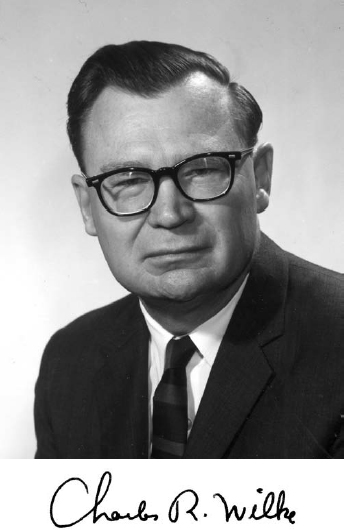1917–2003
Elected in 1975
“For contributions to research on molecular diffusion, development of
microbiological processes, and engineering education.”
BY JOHN M. PRAUSNITZ
CHARLES (CHARLIE) R. WILKE, one of the founders of the Department of Chemical and Biomolecular Engineering at the University of California, Berkeley, died on October 2, 2003. He was 86 years old.
Born in Ohio, Wilke attended the University of Dayton. To meet expenses he organized a dance band in which he played trombone. Following his B.S. degree, Charlie went to Washington State University, where he received a master’s degree working with Professor Otto Redlich, who later was a distinguished chemical thermodynamicist at Shell Development Company in Emeryville, California. Following retirement from Shell, Otto served many years as a lecturer in chemical engineering at Berkeley.
Charlie received a Ph.D. in chemical engineering from the University of Wisconsin, Madison, in 1944, where he worked with Professor Olaf Hougen, one of the leading academic chemical engineers in the country at the time. With Hougen, Wilke established a correlation for mass transfer in systems in which fluids flow through a bed of solid particles like catalysts. This classic correlation is used today all over the world.
Following a brief stint at Union Oil Company, Charlie joined the faculty of the College of Chemistry of the University of California, Berkeley, in 1946. Although many major universities
had established departments of chemical engineering much earlier, it was not until 1946 that the Berkeley campus established a program in chemical engineering. The program was administered by the Division of Chemical Engineering within the chemistry department. A chemical engineering department was not established until 1957. The name was changed to the Department of Chemical and Biomolecular Engineering in 2010. After chairing the Division of Chemical Engineering from 1953 to 1957, Charlie became the first chair of the new Department of Chemical Engineering, a position he held until 1963.
Following his work with Hougen, Charlie’s main research interests at Berkeley focused on mass transfer, that is, the rate of transport of molecules from one phase to another as encountered in numerous chemical engineering operations such as distillation and extraction. Charlie’s research in this area produced numerous publications in which he showed how fundamental science can be usefully applied in chemical process design. Charlie’s work was recognized with some of the highest awards of his profession, including the Colburn Award and the Walker Award of the American Institute of Chemical Engineers (AIChE) and election to the National Academy of Engineering. In 1983, Wilke was included in a list of 30 eminent chemical engineers on the occasion of AIChE’s 75th Diamond Jubilee Celebration.
In the early 1960s, Charlie’s research interests shifted to what was then the very early period of biochemical engineering. Initially, his studies concerned the kinetics of microbial growth and of oxygen dissolving in biochemical reactors. Later, he gave attention to making synthetic fuels (ethanol) from solid wastes such as old newspapers. In his engineering-oriented research during the 1970s, Charlie was 25 years ahead of his time. Thanks to his early initiatives in biochemical engineering, Berkeley is now an internationally acclaimed center for research in that area. At present, the Department of Chemical and Biomolecular Engineering has five faculty members whose primary interests are in applying chemical engineering science to advance the frontiers of biotechnology.
The author of more than 150 scholarly papers, Charlie taught hundreds of undergraduate students and mentored more than 100 M.S. and Ph.D. students. He also served for several years as assistant to the chancellor for academic affairs and was active on many campus committees. In addition to his university appointment, he was a faculty investigator at the Lawrence Berkeley National Laboratory.
Charlie is justly known as the father of chemical and biomolecular engineering at Berkeley. He instilled an unusually strong spirit of cooperation among his colleagues as he guided the growth of the department from 5 faculty members to 16. He also played a key role in making Berkeley’s chemical engineering department preeminent at a time when the discipline was evolving toward the social and economic importance it enjoys today.
Charlie was a superb chair and an outstanding department leader. He had a clear vision of where the department should go. It was during his years as chair that Berkeley chemical engineering quickly rose to prominence. In 1953, Berkeley chemical engineering was virtually unknown in the academic world. Ten years later, thanks to Wilke’s firm yet gentle guidance, it had achieved an enviable worldwide reputation.
Charles Wilke retired in 1987. In recognition of his remarkable contributions to the chemical engineering profession, to chemical engineering educators, and to the University of California, at the graduate exercises in May 1988 the chancellor of the Berkeley campus awarded Charlie Wilke its highest honor—the Berkeley Citation.





